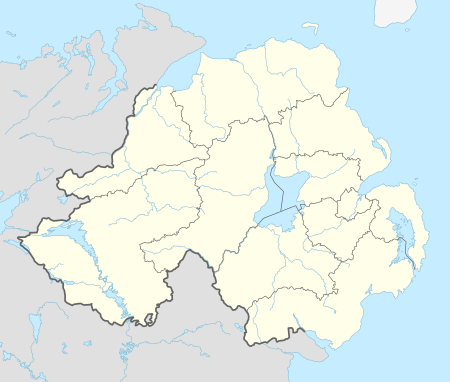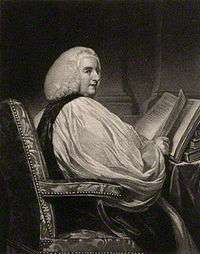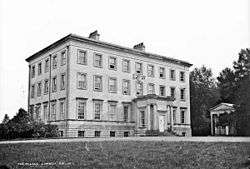Archbishop's Palace, Armagh
| Archbishop’s Palace, Armagh | |
|---|---|
|
North Facade | |
| Location | Palace demesne |
| Nearest city | Armagh |
| Coordinates | 54°20′24″N 6°39′02″W / 54.34000°N 6.65056°WCoordinates: 54°20′24″N 6°39′02″W / 54.34000°N 6.65056°W |
| Built | 1770 |
| Built for | Richard Robinson |
| Original use | Ecclesiastical Palace |
| Current use | Government Building |
| Architect | Thomas Cooley, Francis Johnston |
| Architectural style(s) | Neoclassical |
| Owner | Armagh, Banbridge and Craigavon District Council |
Listed Building – Grade A | |
| Designated | June 25, 1975 |
| Reference no. | HB15/18/016 |
 Location of Archbishop’s Palace, Armagh in Northern Ireland | |
The Archbishop’s Palace in Armagh, Northern Ireland, is a landmark Neo-Classical building located on 300 acres of parkland just south of the centre of the city. The building served as primary residence of the Church of Ireland Archbishops of Armagh for over two hundred years, from 1770 to 1975, and thereafter as headquarters of Armagh City and District Council from then until 2015 when that local authority was replaced following the reform of local government in Northern Ireland in that year.[1]
The Palace was built when then Archbishop Richard Robinson sought to relocate the principal residence of the archbishops from Drogheda to the titular city of his office. Armagh native Francis Johnston, who also designed Dublin’s General Post Office and the archway at the King's Inns, and Thomas Cooley, also a noted architect of the time and designer of Dublin’s Royal Exchange both had an important role in designing the building.[2] The palace currently sits at the centre of the Palace Demesne Public Park, and serves as the office of the Lord Mayor of Armagh, Banbridge, and Craigavon Borough.[3]
History
The Church of Ireland Archbishops of Armagh had not lived principally at Armagh since the reformation, and instead kept residence in the far-south of their diocese near Drogheda, and often actually resided in Dublin, from where they could easily attend the House of Lords.[4]

Richard Robinson was elected Archbishop of Armagh in 1765, which brought with it the Primacy of the Church of Ireland, and was at once dissatisfied with the modest residence provided on English Street, as well as the lack of improvement in the ancient Irish ecclesiastical capital generally. The Archbishop’s Palace was constructed as part of Robinson’s project to revistalise the old city generally upon his succeeding to the See of Armagh.[5] Using the services of Cooley and Johnson, two of the leading architects active in Ireland in the day, Robinson had the large two-storey house, 7 bays wide by 4 bays deep constructed close to the centre of the city on extensive lands owned by the Church, and near what had been a Franciscan Friary prior to the Dissolution of the Monasteries. Other buildings constructed as part of this effort included the Armagh Observatory and Armagh Public Library. Cooley designed the exterior of the house, while Johnson modelled the interior.
Largely unchanged, the building continued to serve as residence for the Church of Ireland Archbishops throughout the 19th century. An additional floor was added in the 1820s, however, for Archbishop John George de la Poer Beresford, whilst the impressive enclosed porch with Iconic columns was also a later addition.
The house and its walled demesne were referred to by Inglis in 1834 as
| “ | in excellent order … laid out with much taste...[6] | ” |
Following the disestablishment of the Church of Ireland in 1871, Archbishop Knox started a fund to ensure that the Palace and its grounds could continue to be used by his successors, as they were no longer being able to rely on tithe income for such purposes.[7]
Archbishop Simms, primate from 1969 to 1980 was the last archbishop to live at the Palace, but ceased to reside there during his tenure. Having been vacated by the Church of Ireland Archbishops, the building was protected by being designated a “Grade A” listed building in 1975, i.e. the status reserved for "buildings of greatest importance to Northern Ireland including both outstanding architectural set-pieces and the least altered examples of each representative style, period and type." [8]
From 1975 to 2015, the building served as the headquarters for Armagh City and District Council until that authority was merged into the Armagh, Banbridge and Craigavon District on April 1, 2015. During that time, the Palace served as the principal civic and administrative centre of the city council, and effectively as Armagh’s city hall.[9]
Today, the Palace sits at the centre of the Palace Demesne Public Park, with a free visitor's centre situated next to it. Public tours of the Palace and its grounds are available during the Summer Season and provide an account of the story of the Demesne through Living History Interpretation with costumed interpreters seeking to recreate both the grandeur and the squalor of the Georgian period for visitors.[10] The Palace has also been selected as the primary office of the Lord Mayor of the newly formed Armagh, Banbridge, and Craigavon Borough, following that local authority's creation in April 2015.
Grounds
The Palace sits at the centre of an estate with a number of buildings which have been awarded listed status in their own right. The Palace itself sits on high ground within its own parkland and affords fine views of the city and the Church of Ireland cathedral.

It is surrounded by grassland to the North, and mixed woodland (largely mature sycamore trees) to the south. There are some 19th century exotic trees near the Palace while a golf course and belt of protective woodland make up the north eastern and north sections of the park. Notable man-made features of the estate include the following:
- A walled garden is at the north end, with a garden house (HB 15/18/14), not cultivated at present;
- A 19th century glasshouse (HB 15/18/20) and ice house to the west of the Palace and there is another ice house near the main entrance (HB 15/18/15 & 19).
- The stables and coach yard (HB 15/18/18), which now serve as a visitor’s centre;
- One of three entrance gates remain, whilst the 18th century gate lodge has been demolished; and
- Ruins of a Franciscan Friary, (SMR ARM 12:16); and
- A Holy Well dedicated to Saint Brigid (SMR ARM 12:17).[11]
Rokeby Obelisk

Atop the high-point of the Palace grounds, Knox’s hill, stands the Rokeby Obelisk erected in 1782-83, at the southern end of the park. This feature was constructed at the instigation of Archbishop Robinson at a time of severe distress in Armagh City, with employment afforded to those who could not find it elsewhere. The Obelisk’s name comes from Rokeby Hall, country seat of Robinson’s father, Sir Thomas Robinson, in the North Riding of Yorkshire and subject of Sir Walter Scott’s epic poem Rokeby (Robinson was to become Baron Rokeby in 1770).
It is dedicated by Robinson to Hugh Percy, 1st Duke of Northumberland, and Lord Lieutenant of Ireland 1763–1765 as Northumberland had been instrumental in securing the Archbishopric of Armagh for Robinson, who prior to that had been Bishop of Kildare. Both the Northumberland family’s and the Royal coat of arms adorn the pedestal, whilst armorial bearings associated with Robinson are detailed on the shaft, as well as his motto, Non Nobis solum sed toti mundo nati.[12]
Standing 113 feet tall, the Rokeby Obelisk has been awarded “Grade B” listed status with designation HB15/18/021.[13]
Primatial Chapel
Also on the grounds, immediately adjacent to the Palace, is the Primatial Chapel, also built for Robinson. In the style of a classic Iconic Temple, its interior is described as one of the most beautiful Irish ecclesiastical interiors, boasting a coffered, barrel-vaulted ceiling; a delicate frieze; Corinthian pilasters; a gallery; magnificent panelling; and pews.[14]
The Primatial Chapel is a Grade A listed building in its own right with designation HB15/18/017.[15]
See also
- County Armagh
- History of Northern Ireland
- List of Category A Listed Buildings in County Armagh
- List of Category B+ Listed Buildings in County Armagh
Sources
- ↑ "Armagh Sites of Interest" (PDF). Department of Environment, Northern Ireland. Retrieved 2015-07-12.
- ↑ "1770 – Archbishop's Palace, Armagh". Archiseek. Retrieved 2015-07-12.
- ↑ SeeArmagh, Banbridge, and Craigavon Borough Council Residents’ Newsletter, April 2015, available at this link: http://www.armaghbanbridgecraigavon.org/wp-content/uploads/2015/04/Residents-Newsletter-April-2015.pdf
- ↑ "Armagh Palace". Lord Belmont in Northern Ireland Blog. Retrieved 2015-07-12.
- ↑ Armagh Palace
- ↑ "REGISTER OF PARKS, GARDENS AND DEMESNES OF SPECIAL HISTORIC INTEREST, NORTHERN IRELAND" (PDF). Northern Ireland Environment Agency Blog. Retrieved 2015-07-12.
- ↑ Armagh Palace
- ↑ "Listed Buildings in Armagh". Northern Ireland Environment Agency. Retrieved 2015-07-12.
- ↑ 1770 – Archbishop’s Palace, Armagh
- ↑ See The Palace Demesne at the Northern Ireland Tourist Board's website, http://www.discovernorthernireland.com/The-Palace-Demesne-Public-Park-Armagh-P2840
- ↑ Register of Parks, Gardens and Demesnes of special historic interest, Northern Ireland
- ↑ George Newenham Wright, ‘’A New and Comprehensive Gazetteer, Volume 1’’ (1834), London, p.259
- ↑ Register of Parks, Gardens and Demesnes of special historic interest, Northern Ireland
- ↑ Armagh Palace
- ↑ Register of Parks, Gardens and Demesnes of special historic interest, Northern Ireland
External links
| Wikimedia Commons has media related to Palace of the Archbishop of Armagh. |
- Sustainandbuild.com - Video detailing maintenance of the Palace
- DIA.ie (Dictionary of Irish Architects, 1720 - 1940) - entry for the Palace
- Youtube.com - clip of the Palace and its Grounds from the air


